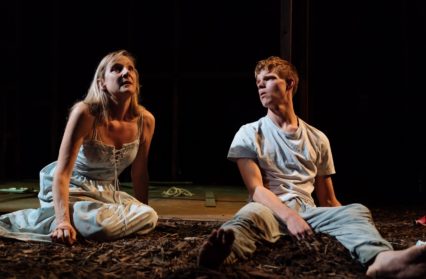The Woods by Robert Alan Evans is a theatre production that explores what it means to care about someone else. Grace Patrick attends a performance at the Royal Court.

On a surface level, The Woods by Robert Alan Evans at the Royal Court is an intriguing exploration of what it means to care about someone else, and how a sense of self can be formed outside of the traditional walls of society. The primary focus is on an unnamed woman who has disappeared into the woods. She’s been alone for a long time, but now she has found a teenage boy unconscious in the snow and finds herself compelled to care for him.
Hovering over all of this is a nameless man- perhaps her son, perhaps a figment of her imagination. All we know is that he exerts great power and that he is played with a terrifying fervour by Tom Mothersdale. His poise and energy fill the room, but it would be hard to miss the raw aggression that he brings with him.
In some ways, it was unclear to me whether the image of the woman alone and totally self-reliant in the woods was supposed to be literal or metaphorical: as the play goes on, it becomes increasingly evident that there are many layers of self-deception at work, to the extent that it would be easy to write it all off as an allegorical exploration of self-isolation. However, I feel that this would miss the point entirely, as perhaps it doesn’t actually matter. Whether this woman, whoever she may be, is literally surviving in the woods that she drove herself into or is simply so cut off that she may as well be, the ideas at its heart remain the same. It’s documentation of the immense emotional fallout of a horrific act, with a deeply ingrained sense of guilt functioning as a driving force throughout.
This play is remarkable for its presentation of total mental chaos. Even moments of apparent lucidity are surrounded by such chaos that it’s hard to believe that they’re not part of whatever illusion is being created. The harsh unpredictability of the scene changes and the characters force us to take our own step into the confusion, keeping us there until it’s finished with us. While The Woods looks at what it means to escape, it simultaneously creates something that’s totally impossible to escape from.
I can’t go this far without talking about Lesley Sharp, playing the Woman. Watching her on stage was a masterclass on how to create a world and live in it. Her use of her own body and space was absolutely incredible to watch: While the script was beautifully composed, I have a sense that she could have told that story without speaking a single word.
Sometimes, complex sets can feel like they’re more for their own sake than for the sake of the production as a whole. However, Naomi Dawson’s beautiful staging made it feel as if building a forest in the attic space of the Royal Court was not only justified but in fact very necessary. It walked a fine line between the symbolic and the believable.
The wonderful thing about this play is that it occupies the small space in between the dark and the gratuitous. Evans’ script holds onto an element of the mythical. Despite telling a deeply tragic story, it is, at its heart, irrefutably human.
For more performances at the Royal Court, take a look at their website.
Grace Patrick is an avid contributor at Wales Arts Review.











